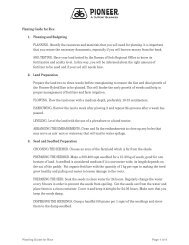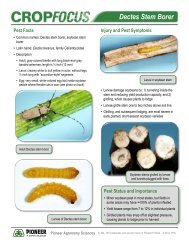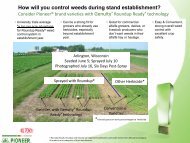Corn Work Shop Book - Pioneer
Corn Work Shop Book - Pioneer
Corn Work Shop Book - Pioneer
Create successful ePaper yourself
Turn your PDF publications into a flip-book with our unique Google optimized e-Paper software.
5. Water management of corn<br />
When is water needed?<br />
The corn plant's development must not be restricted<br />
at any stage of growth if maximum yields are to be<br />
achieved. The relationship between a crop's growth<br />
and water need can best be shown by drawing<br />
the water requirement curve over the weight gain<br />
curve. This is done in Figure 7 and it is obvious that<br />
the water need increases rapidly from about two<br />
weeks prior to tassel and ear appearance until<br />
Dry weight water need<br />
Water requirement<br />
An alternative way of indicating water requirement<br />
was shown in Figure 2 (refer previous section - how<br />
the corn plant develops).<br />
This indicated water requirements each week as a<br />
percentage of total water needs, i.e.<br />
• 20 percent in the first five weeks after<br />
emergence<br />
• 33 percent in the next three weeks (the three<br />
weeks prior to silking)<br />
• 31 percent during the next three weeks during<br />
silking and early grainfill<br />
If an irrigated crop of corn in southern Australia uses<br />
nine megalitres of water per hectare in a normal<br />
season, up to six megalitres are required (and need<br />
Tassel appearance<br />
Silk appearance<br />
about two weeks after full silk and then decreases<br />
rapidly.<br />
It should be noted that Figure 7 only compares water<br />
need and dry weight accumulation on a days after<br />
emergence basis. The fact that there is no scale on<br />
the vertical axis means that there is no comparison<br />
between the amount of water and the weight of the<br />
plant.<br />
Blister<br />
4 28 42 56 66 78 90 02 4 26<br />
Days after emergence<br />
Early dent<br />
Figure 7: Water requirements of corn (dry weight gain)<br />
Full dent<br />
Dry Weight<br />
to be applied) during the six week period from prior<br />
to tasselling to early grain fill.<br />
The water available each day, or the rate at which<br />
that water can be applied to the crop, becomes<br />
very important if timeliness of irrigation is to match<br />
the crop requirements and not limit yield.<br />
How much water is required?<br />
Contrary to what is often said, corn is a relatively<br />
efficient user of water in terms of dry weight produced<br />
for water used. <strong>Corn</strong> requires approximately 370 kg<br />
of water to produce 1 kg of dry weight, compared<br />
with approximately 270 for sorghum, 500 for wheat,<br />
560 for cotton, 630 for oats and 860 for lucerne.<br />
However, because there is a lot of weight in a crop<br />
of corn, it has a high total water requirement.<br />
If the selection of variety and plant population is<br />
adjusted to suit the total amount of water available,<br />
and if the water could be metered out in proportion<br />
to when it is most needed by the crop, we would<br />
4 5<br />
Grain yield ( t/ha)<br />
5<br />
2.5<br />
0<br />
7.5<br />
5<br />
2.5<br />
have a water:grain yield relationship similar to that<br />
shown in Figure 8. Obviously a number of factors such<br />
as heat, humidity, wind etc., can influence the shape<br />
of this curve, but it is a useful guide on which to base<br />
yield goals in relation to the amount of water<br />
available.<br />
0 25 250 375 500 675 750 875<br />
mm of water available to the corn plant<br />
Figure 8 : The relationship between water availability and grain yield<br />
Figure 8 shows that the efficiency of water use<br />
increased rapidly as more water was applied<br />
(provided population keeps pace) until the hybrid<br />
reaches its yield limit.<br />
The soil's capacity to store moisture is a most<br />
important factor as it largely determines the amount<br />
and frequency of irrigations and is of paramount<br />
importance in deciding yield goals under dryland<br />
farming. Figure 9 gives the average water storage<br />
capacity of various soil types. <strong>Work</strong> on corn utilising<br />
1.5 m of soil moisture if there are no physical<br />
restrictions.








